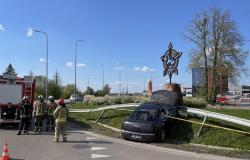However, today the man has been in full remission for almost 2 years and does not feel any symptoms. He was saved by an innovative method of treatment, when immune cells taken from his body – T lymphocytes – were “programmed” by specialists to specifically attack his cancer and those cells were implanted back into his body.
This treatment method applied in Santara clinics of Vilnius University Hospital (VUL) is called CAR-T therapy and is one of the types of advanced therapy. Advanced therapies combine the fields of molecular biology, genetics and cell technology to fight rare and currently incurable diseases.
On March 27, the country’s experts discussed this field of medicine with enormous potential at the conference “Advanced therapy in Lithuania: present, perspectives, problematic aspects” organized by the Lithuanian Science Council (LMT) together with the National Health Council (NST) and the Center for Innovative Medicine (IMC).
Oncological diseases are one of the most relevant areas
As a portal 15 minutes explains LMT chairman dr. Gintaras Valinčius, advanced therapy marks a certain paradigm shift in medicine. Usually, when we turn to specialists, they “treat not us, but our disease.” What influence standard treatment will have on our body in particular is seen less.
Meanwhile, in advanced therapy, which is closely related to personalized medicine, the latest scientific discoveries are used precisely for the individualized treatment of patients (with all their peculiarities).
“Personalized, advanced medicine treats you, the individual. Diagnostic methods are aimed at finding out how it affects your body personally, what fits, what doesn’t fit, what works, what doesn’t,” says the chairman of LMT.
LMT photo/Gintaras Valinčius
According to dr. G. Valinčiaus, advanced therapy methods are currently used in the treatment of extremely serious and rare conditions: cardiovascular, metabolic diseases, neurodegenerative diseases, such as Alzheimer’s or Parkinson’s. Damage to the joints, skin or lungs is no exception.
However, one of the most common areas of application of advanced therapy is oncological diseases – those cases when conventional treatment methods do not work. Specifically, blood cancer is treated using the so-called CAR-T therapy, when immune cells are genetically modified.
“Some forms of blood cancer do not respond to treatment with the usual methods that we have. Then another possibility is to treat these cancers, namely certain lymphomas and leukemias, with immune cells – T lymphocytes that have been genetically modified to kill lymphoma or leukemia,” – 15 minutes says Prof. Dr. Laimonas Griškevičius.
Most patients have complete remission
According to the head of the Hematology, Oncology and Transfusion Center of VUL Santaras Clinics, this innovative technology was introduced in Santaras Clinics in 2018, and the treatment was applied to a patient for the first time in May 2022.
At that time, the man suffering from cancer had already lost hope of recovery, because the disease progressed quickly, and all other types of treatment were ineffective.
“The patient had been ill for many years and had been treated with many treatments. Chemotherapy and blood stem cell transplantation were used, after which the disease relapsed several times, and targeted therapy was prescribed, but all these treatments were ineffective. Even the application of the most modern methods currently available did not benefit the patient.
123RF.com photo/Blood cancer
The disease progressed really quite quickly, (…) it was quite widespread and basically the patient only had two knees. One way was simply relieving the symptoms, and the other way was to try to treat with this new method”, asserts Prof. Dr. L. Griškevičius.
The doctor is happy with the success – almost 2 years after the first application of CAR-T therapy in Santara clinics, the man “is healthy and does not receive any treatment”. Many of the 24 blood cancer patients who received this treatment are now in complete remission.
“According to our preliminary results, 8 out of 10 patients have achieved complete remission. According to medical literature, about two-thirds of patients remain in full remission for a long time,” says the interviewer.
Conventional treatment can be used for recurrent cancer
Currently, when the technology is fully implemented in Santara clinics and all permits are obtained, no more than two weeks pass from the decision to apply CAR-T therapy to its start. Although certain complications are possible after applying the treatment, they are not serious for many, assures Prof. Dr. L. Griškevičius.
“This treatment is more characterized by immune complications – aggravated inflammation syndromes, which appear in some patients after a week. (…) At that time, patients may start to have a fever, there may be blood pressure fluctuations, and cases of lung damage. All these complications are treatable. In our experience, many patients had minor complications,” says the expert.
It is interesting, he continues, that for a part of patients whose blood cancer returns after a certain time, previously applied conventional treatment methods, which until then did not bear any fruit, may become effective.
“Now the disease is, let’s say, insensitive to the way the targets are treated, so we’re using CAR-T immunotherapy. After immunotherapy, if, for example, the disease comes back, targeted therapies can start working again because the part of the disease that was sensitive to the targeted therapy has come back.

Photo of Santara Clinics/Prof. Laimonas Griškevičius
Some of these patients return to their previous treatment or are scheduled for another treatment, including a donor bone marrow transplant. For some, repeated application of CAR-T treatment can also be attempted,” says the head of the Hematology, Oncology and Transfusion Center of VUL Santaras Clinics.
Disagreements on legal regulation
Scientists and medical practitioners constantly emphasize the enormous potential of advanced therapy. However, there are many obstacles on the way to its wider practical application, 15 minutes emphasized the chairman of LMT dr. G. Valinčius. One of the biggest problems is insufficient funding.
“As for the problems of our institutions, they need to solve a number of tasks related, first of all, to infrastructure and new laboratories. (…) In the technological sense, these are complex premises, not at all reminiscent of ordinary ones. They control dust pollution, air composition, microbial, biological pollution, and maintaining this is associated with very high costs,” the expert teaches.
Access to advanced therapies is hindered by high costs. For example, the cost of some commercially available gene therapies for the treatment of severe nervous system diseases reaches more than 2 million dollars. Euros. Chairman of LMT dr. G. Valinčius hopes that greater cooperation between scientists, medical practitioners and engineers will help to optimize and strengthen processes in the long run.
“As advanced medicine treatment methods move from experimental status to more routinely used, I think there is a very high potential to make the treatment of such diseases at least tenfold cheaper. (…) Maybe in the future there will be specialized centers where [ląsteles] will take it from the patient, modify it and return it to the same center, which will make the whole process and logistics cheaper,” says the interviewer.
Speaking about the problems hindering the development of advanced therapy, Dr. G. Valinčius also names the legal regulation, which is closely related to the ethical issues of such treatment. Just as experts disagree about genetically modified foods, so too do they disagree about modifying human cells.

123RF.com photo/Cancer treatment
“You can handle the test tube unethically – you can drop it on the ground and break it.” And with a person, both as an object of research and as an object of treatment, there is a very strict regulation. We are talking, for example, about human cells, which are the primary source of a new drug. Cells are taken from the patient, transferred to the laboratory, reprogrammed in the laboratory, and their functions are changed.
(…) You have probably heard about GMOs. This GMO is not only sometimes lying on the shelves of supermarkets – there are GMOs here too. Hence, there is a huge burden on medical scientists, medical practitioners, how to take into account all those regulatory requirements, but at the same time to produce the drug, use it and cure the patient”, says the chairman of LMT.
Tags: Advanced therapy saves hopeless patients cells programmed laboratory fight cancer Life
-








